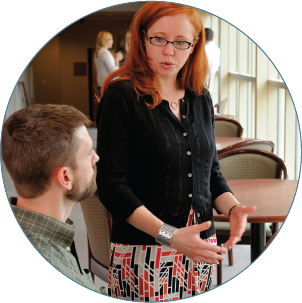The Value of Greenways
In an increasingly digital world, the economic fortunes of a community can be dependent on a quality of life it provides to residents. Investments in greenway systems — trails lined with trees, vegetation, or other natural features — are a way that some local governments choose to enhance quality of life by providing recreational opportunities and leveraging underutilized amenities. Greenways often following a natural feature such as a river or disused railroad bed.
Boston’s Emerald Necklace, constructed in the 1880’s is usually recognized as the first major U.S. greenway, and connects 1,100 acres of parks through seven miles of trail. More recent examples include New York City’s High Line or Atlanta’s BeltLine. Many North Carolina communities, large and small, have made public investments in greenways. Kinston, for example, recently completed the first phase of its downtown Arts Riverwalk and Durham has over 30 miles of greenways and trails within its City limits. As communities build or expand greenways, they should understand and consider the value of these trails can bring.
Land Value
As shown below, several recent empirical studies have shown that greenways positively affect home prices. John Crompton, a professor at Texas A&M, uses a “conservative” estimate that greenways increase the value of homes within 600 feet by 5%. Unfortunately, he notes that there is insufficient data to estimate the increase of value for non-residential land.
|
Location |
Year Published | Change in Land Value |
| 2009 | 5% premium for homes proximate to greenways | |
|
2006 |
4% premium for homes proximate to greenways (specifically bike paths) |
|
| Austin, Texas | 2005 |
Statistically significant increase for homes less than half a mile from a greenway |
Crompton’s estimate corroborates extensive anecdotal evidence from surveys in California, Colorado, Nebraska, Vancouver, and Washington State, which all found that realtors and homeowners thought proximity to trails was a useful selling feature for homes. Indeed, the recent construction of high profile greenways appear to have had a positive impact on surrounding land values. The New York Times reported that the construction of the High Line spurred investments in nearby neighborhoods amid the financial crisis. The building of Atlanta’s Beltway has even prompted concerns that the greenway would accelerate gentrification.
In general, greenways appear to increase or at least do not reduce land values. However, results are heavily dependent on local conditions. For example, a 2003 Reed College study examined a trail system that connected homes to undesirable industrial areas. In this case, home prices dropped by 6.8%. A 2004 study into the impact of greenways on home prices in Indiana found that one greenway significantly increased home values, while others multiuse trails in the same community had no impact on prices. These outcomes underlie the need for planners to pay attention to local factors and conditions.
Quality of Life
Greenways add to land value by contributing to the quality of life for residents. This is primarily through serving as a site for leisure and recreation. Advocates also point to several additional environmental and health benefits of greenways. If people use the trail system to commute, then the trail system will abate air pollution. Greenways can also reduce flooding and encourage individuals to exercise. Some greenways, like Atlanta’s Beltline, also aim to promote community cohesion.
In practice, the benefits of trails may not always be evenly distributed. For example, a 2011 study found that a greenway in Greenville County, South Carolina was being used disproportionately by individuals who are white and male. The same study reported that nine in ten trail users said they used it for exercise only, while 9% reporting using it for commuting. Users travel 9.2 miles on average to reach the trailhead.
Some groups have voiced concerns that greenways may promote crime, even though experts have struggled to support this assertion. For example, studies have shown that poorly designed or maintained parks may promote social and racial segregation, eventually leading to increased crime. However, this association is not specific to greenways – underutilized land and poorly designed infrastructure in general can promote segregation and crime. Other studies have also shown that under other circumstances, greenways are associated with a reduction in crime.
Considering a Greenway?
Well-designed greenways can be a valuable asset for communities. They can contribute to the economic, social, and environmental wellbeing of residents. However, when designing a greenway, planners and government officials should always be mindful of local factors that will determine the success or failure of a specific project.
Bradley Harris is a Masters student at Duke’s Sanford School of Public Policy as well as an MBA Candidate at the UNC-Chapel Hill Kenan Flagler Business School. Bradley is also currently a Community Revitalization Fellow with the Development Finance Initiative.




